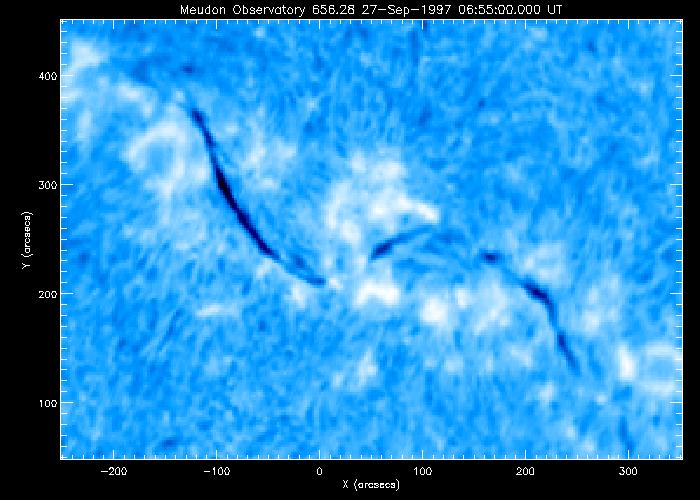
A Summary of the September 1997
Filament
In the summer of 2000 I worked with Paul Wood, a student of Eric Priest at St. Andrews, and we studied the evolution of a few large, very visible, and long-lived filaments, observed by a number of solar spacecraft as well as ground-based observatories. The idea was to further verify a theory of filament formation and evolution that I was working on at that time, and to collect neat images and movies to illustrate my results in seminars.
It worked! Paul did an outstanding job that summer in collecting and presenting data, which convinced me I was right. Key point: filaments form in filament channels, regions that have no magnetic connections above the surface prior to the formation of the filament, through a process that Kees Zwaan and I called "head-to-tail linkage". This process is driven by flux cancellation, a phenomemon that Sarah Martin pointed out already in the 80's as the driver for filament formation. As a byproduct Kees and I found that filament formation through "linkage" provides a simple explanation for the observed hemispheric chirality rules for filaments, a phenomenon also discovered by Sarah Martin.
If you interested in the theory, read the Sept. 2001 ApJ paper by myself and Kees Zwaan, and for the observations see the references therein. The purpose of this nugget is merely to show the observations of just one filament, and anyone can interpret this as according to her or his favorite theory.
To start with, here's a hydrogen-alpha image of the filament. You can
see that it is a lot thinner than the August filament, and much more
clearly defined. It is also easy to see the white patches on the image,
around the filament. These correspond (as seen later) very well with
regions of stronger magnetic field.

Here's the full range of types of image, all taken on the 27th September 1997. From left to right we have: hydrogen-alpha, helium-1, MDI magnetogram, Yohkoh soft x-ray and finally EIT ultra-violet. As you can see (click the thumbnails to enlarge as usual) the filament is placed along the neutral line of a rather strong area of magnetic field. The same region shows up very clearly in each image, as oppose to the August filament, where it was more difficult to pick out features in the magnetogram or x-ray images. So now we have a full range of image types that all show something about this filament. Theoretically, it should be easier to produce and study interesting images.

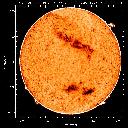
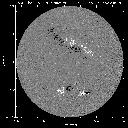
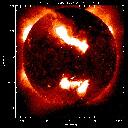

Here is an example of the magnetogram image contoured over the hydrogen alpha. If you click on the image, you can see the full set of them. It is obvious straight away that the magnetic neutral line is where the filament sits, and the whole thing is more clear than for the August filament.
Here, rather than post a list of all the hydrogen-alpha images, they have been made into two short movies. It is best to view these slowed right down, since there are only 10 and 8 images in each, respectively. The first shows the early formation of the filament, and the second the week before it erupts. It is interesting to see the way the filament retains it's s-shape for such a long period of time. Hopefully it should also be clear that the filament grows and connects up during the month before its eruption.


These are the first animations of the overlayed images. If you click
on the image, the movie will load and play, but it can't be controlled
like the other movies. (Caution: large movie, 1.8 Mbyte)
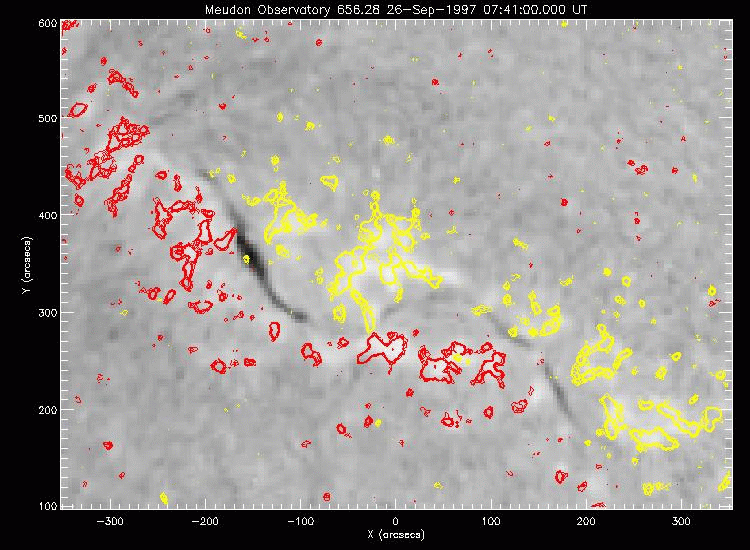

This is a movie of the early movement of the magnetic field. It covers
a couple of days, from 31st August to 2nd September 1997. Bear in mind
when you look at it that the filament lies along the polarity inversion
line. (Caution: large movie, 6.2 Mbyte)
This is the extent of the images we dug up for this filament. It covers the main properties: Paul has been able to chart the formation of the filament, show flux cancellation and the correlated "head-to-tail linkage" of segments. It is clear that such a large filament outside the sunspot zone cannot form through the emergence of a pre-existing flux tube through the photosphere: flux emergence in these regions occurs on much smaller length scales.
April 26, 2002
Piet Martens (martens@physics.montana.edu)